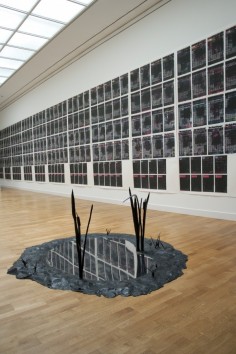Angus Fairhurs

source: contemporaryartdaily
Angus Fairhurst (1966-2008) was one of the most influential members of the group of artists associated with London’s Goldsmiths College in the late 1980s. Fairhurst participated in the seminal exhibition, Freeze, in 1988, which introduced the world to a generation who became known as the Young British Artists, setting the tone for contemporary art in the UK over the next two decades. The retrospective at Westfälischer Kunstverein is the first major exhibition of his work in Germany.
Angus Fairhurst’s work eludes straightforward categorisation, encompassing sculpture, painting, performance, photography, video, music, printmaking, drawing and collage. Over more than twenty years he engaged with specific formal and thematic motifs including blank spaces, gorillas, cycles and repetitions. His work touches on themes such as selfhood, desire, advertising and mass reproduction, his combination of conceptual strategies merging into an idiosyncratic and subtle formal vocabulary.
The artist found a source for his complex collages in advertising, with its constantly repeated paradigms of female beauty and diverse design concepts. By freeing these from their representative function, Fairhurst enabled them to take on a new form which revealing his fascination with the aesthetics of surfaces, while their palimpsest-style array of layers dramatises the idea of mass reproduction. Much of Fairhurst’s activity centres in this way on repetition and dichotomy: evoking the spirit of Samuel Beckett or Bruce Nauman, he explored the way in which loops and superimposition serve as metaphors for the absurdity of everyday life. The works’ ostensible meanings are constantly confronted by a sense of their own travesty or subversion: “It’s like saying a word over and over again until it loses its meaning, and then it gets it back again“ (Fairhurst).
Although the artist’s oeuvre is complete due to his early death there are many conceivable possibilities for continuation inherent in it. Drawing upon art-historical references including Romanticism and Dada, it simultaneously has its roots in more recent conceptual trends. This retrospective provides Westalischer Kunstverein with an opportunity to honour one of the most innovative and individual figures in British art of the last three decades.
Angus Fairhurst (1966, Kent, UK – 2008) graduated from Goldsmiths College in London in 1989. Following Freeze (1988), Fairhurst exhibited in most of the landmark group exhibitions of his generation, including Gambler (1991) at Building One, London, Brilliant at the Walker Art Centre in Minneapolis (1995), Some Went Mad, Some Ran Away at the Serpentine (1994), Apocalypse at the Royal Academy (2000), and In-a-Gadda-da-Vida, with Sarah Lucas and Damien Hirst, at Tate Britain (2004). He also had a number of significant one-person exhibitions, notably This Does Not Last More Than One Second at Spacex Gallery, Exeter (2001), at Sadie Coles HQ, in London, and at galleries in New York, Berlin, Sao Paulo, Vienna and Amsterdam. Music performances by Fairhurst’s band, originally called Low Expectations, took place at an international range of venues from 1995-2001. In Belgium his work was shown at S.M.A.K. during the Casino 2001 exhibition in 2001.
.
.
.
.
.
.
.
source: finslab
Angus Fairhurst foi um artista Inglês trabalhando na instalação, fotografia e vídeo. Ele foi um dos jovens artistas britânicos.
Vida e obra
Angus Fairhurst nasceu em Pembury, Kent. Tendo frequentado a escola Judd entre 1978 e 1985, ele estudou na Canterbury Art College 1985-1986, e formou-se em 1989 em Belas Artes no Goldsmiths College, onde ele estava no mesmo ano como Damien Hirst. Em Fevereiro de 1988, Fairhurst organizada uma mostra do trabalho do aluno, que foi um precursor ao congelamento espetáculo em grande parte organizado por Hirst em julho de 1988, com dezesseis outros estudantes de Goldsmith, incluindo Fairhurst. Fairhurst e Hirst se tornaram amigos íntimos e colaborou em vários projetos. Fairhurst também foi durante vários anos o parceiro e, por vezes colaborador de Sarah Lucas.
O trabalho de Fairhurst foi muitas vezes caracterizado pela distorção visual e brincadeiras. Em 1991, ele fez uma peça em que ele ligados em rede os telefones dos principais negociantes de arte contemporânea em Londres, de modo que eles só poderiam falar uns com os outros – um comentário espirituoso e dizendo que o mundo da arte é muitas vezes apenas interessado em falar para si mesma.
Trabalhou em diferentes meios de comunicação, incluindo vídeo, fotografia e pintura, e é conhecido por suas esculturas de gorilas.
Angus Fairhurst exibido nacionalmente e internacionalmente após a graduação da Goldsmiths. Exposições incluem congelamento e alguns foram Mad e Alguns fugiu, Brilliant! no Centro de Arte Walker e Apocalypse na Royal Academy em 2001. Uma exposição de 2004, em um Gadda Da Vida, foi realizada na Galeria Tate com Hirst e Lucas.
Angus Fairhurst é representado por Grimm Gallery em Amsterdã.

